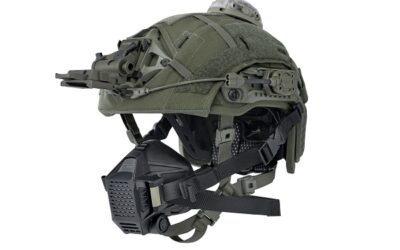Leonardo’s SAGE ESM could commence flight trials onboard General Atomics’ MQ-9B SkyGuardian UAV in 2020
This news follows reports in early February that Leonardo was examining the integration of this Electronic Support Measure (ESM) onboard the MQ-9B. The MQ-9B is the airframe upon which the Royal Air Force’s (RAF) Protector-RG1 UAV is based. Up to 16 airframes could equip the RAF from the outset. This could later increase to 26 aircraft according to US Defence and Security Cooperation Agency documents. The addition of the SAGE ESM on the RAF’s UAVs could further enhance the Electronic Intelligence (ELINT) collection capabilities of the force. These have been improved over the past six years through the acquisition by the RAF of several dedicated airframes as detailed below.
According to Leonardo Sage can collect Communications Intelligence (COMINT) and Electornic Intelligence (ELINT) over a bandwidth of 0.5 megahertz/MHz to 40 gighertz/GHz. It has a sufficient sensitivity to detect RF (Radio Frequency) transmissions of -60 decibels/milliwatt (dBm), with a sensitivity of -80dBm being achievable. Sage provides a geolocation accuracy of five degrees and can detect pulses of 50 nanoseconds duration for fixed, agile and agile discrete emitters. With an emitter library of up to 16,000 mode lines, the addition of the Sage to the RAF’s ELINT capabilities would be an important step. Open sources state that the MQ-9B has an operational altitude of circa 25,000 feet/ft (7,500 metres/m). This affords the aircraft an impressive line-of-sight range of 194 nautical miles/nm (300 kilometres/km), translating into a 118,177 square nautical mile (405,335 square kilometre) area over which the aircraft could keep watch. An MQ-9B/Sage ensemble would represent a versatile theatre/operational level SIGINT capability. The aircraft would complement the RAF’s Boeing RC-135W Airseeker and Beechcraft King Air-350 Shadow-R1 SIGINT and ISR (Intelligence Surveillance and Reconnaissance) collection aircraft, and the British Army’s Thales WK-450 Watchkeeper UAV. This aircraft can accommodate QinetiQ’s AS3 COMINT payload which covers a 30MHz to one gigahertz waveband, according to company literature. It provides a direction-finding accuracy of between three and five degrees. When equipping the WK-450 the AS3 could gather COMINT across a 75,440 square nautical mile (258,751 square kilometre) area when the aircraft is flying at 16,000ft (4,877 metres/m). This would make it a useful tactical/operational COMINT collection platform.
Capabilities
The UK COMINT gathering footprint improves still further when using the Shadow-R1. This aircraft can cover an area of circa 113,354 square nautical miles (388,793 square kilometres) when flying at 24,000ft (7,315m). Meanwhile, the RC-135W can cover as much as 237,463 square nautical miles (814,475 square kilometres) when cruising at 50,000ft (15,240m). Thus an MQ-9B equipped with Sage could act as a useful bridge between the arguably more tactical/operational capabilities of the WK-450 and Shadow-R1, and the operational/strategic capabilities of the RC-135W. The addition of a SIGINT payload onboard the MQ-9B could allow the aircraft to perform either routine COMINT/ELINT gathering missions freeing up the RC-135W to perform other more urgent or specialised tasks. Alternatively, like the WK-450, the MQ-9B could gather SIGINT in, or near, contested airspace where the deployment of an inhabited SIGINT asset may be deemed too risky.
Although the Sage ESM is not yet a formal requirement for the UK’s MQ-9Bs and is hence not under contract Dave Appleby, vice president of EW marketing and sales for Leonardo, says that the ESM would provide “a tactical picture which will immediately be available the commander on the ground or at sea.” He adds that, as with all UK airborne EW platforms, the ELINT it gathers will help populate the country’s Defence EW Database located at the Joint Electronic Warfare Operational Support Centre at RAF Waddington airbase, eastern England. This database provides a continually updated ELINT library to aid platform protection, as well as helping the British armed forces manoeuvre effectively in the electromagnetic environment. Integration of the Sage ESM onboard the MQ-9B is currently ongoing, with flight trials expected in 2020. Ground testing of the SAGE ensemble for the MQ-9B will take place at Leonardo’s facilities in Luton, southern England, Mr. Appleby continues. Aircraft integration will be performed in the US with General Atomics with flight trials commencing therein. He adds that “results from these trials will be made available to all MQ-9B customers, including the UK, and will shape the future of SAGE as a baseline offering on the MQ-9B.”
European Trends
Potential UK interest in SIGINT capabilities onboard UAVs reflects the interest to this end witnessed in several of Europe’s NATO members over the past year. Raytheon’s German subsidiary has developed its Advanced Radar Detection System which has been demonstrated onboard an MQ-9B. This technology is based on the company’s Emitter Location System developed for the Luftwaffe (German Air Force) Panavia Tornado-ECR air defence suppression aircraft. This covers a one gigahertz to 26GHz waveband. This can be expanded upwards to 40GHz or downwards to 500MHz. The ARDs boasts a direction-finding accuracy of under 0.5 degrees and a sensitivity of below -80dBm. The Luftwaffe is expected to procure a new SIGINT gathering UAV in the form of the Northrop Grumman MQ-4C Triton platform to be known locally as the MQ-4C Pegasus. This follows the demise of the air force’s RQ-4E Eurohawk SIGINT gathering UAV in 2013. Four MQ-4Cs could be procured with the first entering service in circa 2025.
Turkey has meanwhile blazed a trail in UAV-based SIGINT through the acquisition of the Turkish Aerospace Industries Anka-1 aircraft, itself based on the Anka-B UAV. Few details have emerged regarding the aircraft’s SIGINT capabilities, although it is thought to have supported ongoing Turkish military operations against Kurdish armed groups in Syria. Publicly available photographs of the Anka-1 reveal it to possess an array of Very/Ultra High Frequency antennae. These are distributed across its ventral fuselage. They maybe used to provide accurate direction finding for signals of interest. The two antenna fairings positioned on either side of the aircraft’s forward fuselage could be used for general COMINT/ELINT collection. The aircraft has a number of antennae mounted on its dorsal fuselage which may be used to transmit this intelligence to enable its analysis in real time.

























